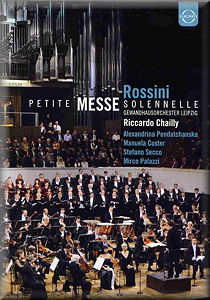 |
 |
|


alternatively
CD:
MDT
AmazonUK
AmazonUS
|
Gioachino ROSSINI (1792-1868)
Petite Messe Solennelle (1864)
 Alexandrina Pendatchanska (soprano)
Alexandrina Pendatchanska (soprano)
Manuela Custer (Alto)
Stefano Secco (tenor)
Mirco Palazzi (bass)
Choir of the Leipzig Opera; The Gewandhaus Choir
Gewandhausorchester, Leipzig/Riccardo Chailly
rec. live, Gewandhaus Leipzig, 6-7 November 2008
Picture format DVD: NTSC. 16:9. Sound formats: PCM Stereo, DD 5.0, DTS 5.0
Booklet notes in English, German, French
Subtitles: Latin, English, German, French, and Spanish.
 EUROARTS 2057428
EUROARTS 2057428  [85:00]
[85:00] 
|
|
|
Gioacchino Rossini's Petite Messe Solennelle was written
in 1863, the last, the composer called it, of my péchés
de vieillesse (sins of old age). He wrote the work for the
consecration of the private chapel of the work’s dedicatee,
Countess Louise Pillet-Will, a personal friend. For its first
performance on 14 March 1864 Rossini arranged the work with
only two pianos, harmonium, four soloists and a choir of twelve.
Partly for fear that it would be done anyway after his death,
Rossini discreetly orchestrated the Petite Messe Solennelle
during 1866-67 and in doing so the king of opera buffa showed
his skill in counterpoint in the two extended double fugues,
much as Verdi had done in the finale of his last opera Falstaff.
The resulting orchestrated version had its first public performance
on 28 February 1869, three months after the composer's death.
The magnificently orchestrated version was performed at the
Leipzig Gewandhaus in November 2008 on the occasion of the 140th
anniversary of the composer's death. The Gewandhaus Orchestra,
along with Kurt Masur, its conductor at the time, will always
be remembered for their part in the fight for freedom in 1989
as the East German Government sought brutally to repress the
population. The stand they took against the repression precipitated
the fall of the hated Berlin Wall and the re-unification of
Germany. Is it too far to stretch the appropriateness of a performance
of a Latin Mass, and its promises of eternal life, with the
ideal for which they stood? Certainly these choral and orchestral
forces, along with distinguished soloists, in the magnificent
theatre and under the baton of a renowned Rossinian, brought
such thoughts to my mind.
The joint choruses, with the women of the two choirs distinguished
by dress, and all the men in white tie, sing with a thrilling
clarity and commitment that not only shakes the rafters but
warms the soul. They open softly in the Kyrie (CH.2),
are fully vibrant in the opening of the Gloria (CH.3)
and are outstanding in the contrapuntal Cum Sancto Spiritu
(CH.8). The orchestral contribution is equally magnificent with
low strings and wind notable in the opening as are the brass
and wind in the Gratis agimus tubi (CH.4). Before mentioning
the singers I must also highlight Rossini’s writing for the
organ in the Preludio religioso (CH 12) and the organist
Michael Schönheit on the large and magnificent instrument from
which he draws such elegiac sounds. It is particularly interesting
to see his pedal work in close-ups as well as hands moving over
the keyboard. The muting mechanism gives further insight into
the tonal diversity of this quite large and magnificent instrument.
The solo singers are well up to their task. The two ladies,
the tall blonde Manuela Custer, with a sappy resonance and suitable
lower notes, alongside the dark-haired warm dramatic coloratura
soprano of Alexandrina Pendatchanska, blend well in the Qui
tollis (CH.6). I might suggest they blend far better than
the famous female duo in the recent recording of the Stabat
Mater (see review).
Pendatchanska’s creamy tone is heard to advantage as soloist
in the Crucifixus (CH.10) whilst the alto has the concluding
long Agnus Dei (CH.15) in which her singing is a glory
in itself. Whilst the ladies hark from Bulgaria and Romania,
the two men are native Italians. Perhaps Mirco Palazzi, whilst
his pitching and expression allied to smooth legato is fine,
could do with a little more sonority and gravitas, (CHs.3 and
7). When we often grumble of tasteless tenor singing, the native
fluent squilla of Stefano Secco’s lyric tenor lays easily on
my ear, particularly in the Gratius (CH.4) with its echoes
of the Cujus animam from the composer’s Stabat mater.
This work is titled Petite Messe Solennelle. It is neither
small nor, in this dramatic reading by Riccardo Chailly, can
it be deemed solemn. If this creation is a sin, my old age,
and many others, could be better used! This performance strongly
gives the work the right to claim as an equal to stand alongside
the composer’s other great choral work the Stabat Mater,
and elevates it to be counted in the company of that other great
Mass composed by a renowned composer of opera, Verdi.
The camera-work is nicely balanced between orchestra, instrumentalists,
audience and chorus with the odd view of the dynamic Riccardo
Chailly. His reading is profound, bringing out colours and drama
that many others have failed to appreciate. The booklet essay,
in English, German, French, is brief but informative.
Robert J Farr
|
|

